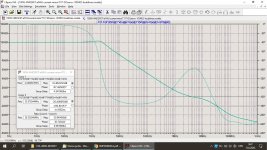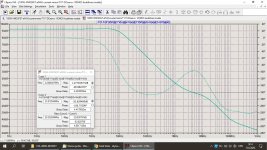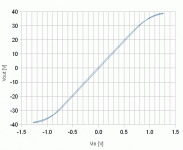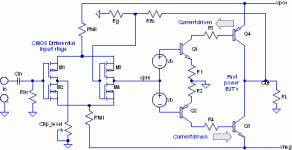I'll prefer to use 2-factor estimation.
1. Feedback depth at highest audio freq, say 20 kHz for simplicity, combined with unity-gain freq. Now there are no point to design an amp with less than 100 dB at 20k, which paired with 3EF OPS will have straightly unmeasurable distortion. Yes, THD can be measured using compensation methods aka distortion magnifier, but there out of diy interest at those FB depths.
I have not yet designed an amp with Feedback of 100 dB at 20 kHz, but here are LG plots of one of my CFA design, I think it's good enough.🙂
Second one is with some shunt load of the VAS.
Attachments
I think it's good enough.
Yes, very good!
Let us suppose that you decided to design more predictable and stable amp instead of chasing the uncommon fb-depth.I have not yet designed an amp with Feedback of 100 dB at 20 kHz
😉
Yes, very good!
Let us suppose that you decided to design more predictable and stable amp instead of chasing the uncommon fb-depth.
😉
You suppose correct.😉
Hi Sandrohv,Hi Ian, the take away I get from your post is that there is no need to strive for 0% distortion but for inaudible distortion. The inaudible levels are (from your post):
"The level for 2nd harmonic to be audible is about 1% (-40dB) and 0.1% for 3rd harmonic (-50dB). That's for the average listener; if your hearing is above average you may add another 10dB. Then add a safety margin of 10dB."
Also, given that sensitivity to harmonics increases with frequencies at a slope of ~50dB/dec on average (from your picture and explanation), harmonics ought to decrease at a slope of -50dB/dec or better.
Am I correct with this summary?
It's a start. It is not mandatory to have a slope of -50dB or better. This is a test for a fork in the decision tree. When the slope is -50dB or better then the next step is to apply the first criteria to the lower harmonics. All the higher harmonics can be safely disrearded as irrelevant what we might be able to hear.
Or 2) if the slope is -40dB or less then we need to consider the effect of the higher harmonics and not just the lower ones on what we might be able to hear. This is more difficult to do to get a quantifiable value. But it can be done...
My article in Linear Audio Vol.4 covered using two or three A-weighted filters in cascade for this (also two CCIR-468 filters) and I did listening tests with a NJL3281/1302 output stage to see if these filters allowed crossover distortion to be accurately quantified relative to our hearing threshold for the lower harmonics (those you quoted). Both seemed to work well but I have never seen this method used or had any contact from anyone about it.
I was like you designing for as low THD as possible but now I can confidently use these methods to predict amplifier sound quality without resorting to ultra-low values. I recall Nelson Pass saying at a BAF talk, "The only reason you want really low distortion readings is you don't know how low is low enough, right?" (or similar words).
The key is how to be sure the amplifier's harmonic spectrum is below audibility for normal operating conditions. But the caveat is: it depends on speaker sensitivity (and room size and desired average SPL). This approach can't be done in general and that may be why it can never be applied to commercial amplifiers. Only custom situations, or it must be limited to certain speaker sensitivities to be a valid assessment.
Hi Sandrohv, See below:Hi Ian, regarding soft-clipping, where do you place the start of soft-clipping? I.e. at 80%, 90% of full power.
While I cannot say I am advocate, it just has been the way I have done things, I have always implemented hard clipping with fast recovery. This is the op-amp way. As a result, I would be interested in knowing more on how soft-clipping is implemented.
My topoloy for the above effect is below:
M1 and M2 do the soft clip, sort of outside the feedback path.
BTW the "clip level" pot in my CSD and Cube amps are an opto-SSR driven by a temperature sensor, so when the heatsink gets above 60 degC the clip level reduces and limits the heatsink temperature dynamically and hence gives dynamic SOA. The advantage is you can hardly hear when this limiting occurs unlike most SOA protection. My Supplement 2+ has more here IansCubelawAmps - Google Drive
Also see Bob Cordell's book for his Klever Klipper.
Attachments
Thanks... I guess??? 😕
I think at the end of the day is personal preference. Perfect amp vs. Imperfect amp that sounds good to the owner.
If you can find the imperfect amp whose imperfections sound amazingly good to you, well then it is the perfect amp for you.
Assuming that imperfect sounds better to anyone (when tested double-blind), sure.
But trying to _sell_ "imperfect" as "better" is borderline fraudulant to my mind, yes say "coloured", "valve sound", anything that describes and admits the difference, but not "better" - that's a claim that would take some justifying!
Assuming that imperfect sounds better to anyone (when tested double-blind), sure.
Mark, revealing that position is the purpose of my philosophical question, to make starkly clear one's most important system objective. What is he primary purpose of one's home audio system? Does one most value musical satisfaction, which is the pursuit of an emotional goal, or parameter satisfaction, which is the pursuit of an intellectual goal. As engineers, we are often drawn to the Platonic ideal of perfection, to it's intellectual beauty. But we should ask ourselves, are the technical specifications a means, or are we treating them as an ends to themselves? For someone to value what their eyes read on some list of specifications, over what their ears experience them via the music itself would seem puzzling to me. Just to be clear, I'm not attempting to offend anyone, just a discussion of thoughts.
What's being overlooked, I suspect, by persons prioritizing the specifications sheet, is the full behavior the final link the the system chain. The human ear-brain element. What I'm suggesting is that a full inclusion of the ear-brain behavior is not sufficiently incorporated in a philosophy of pursuit of ever decreasing parametric errors uber alles. As the ear-brain is an element in a holistic view of an home audio system, it's behavior cannot be slighted in properly defining the optimum behavior of the system's electrical parameters.
But trying to _sell_ "imperfect" as "better" is borderline fraudulant to my mind, yes say "coloured", "valve sound", anything that describes and admits the difference, but not "better" - that's a claim that would take some justifying!
We must be careful with semantics here. Whether a component is 'better' depends upon what the component is designed to deliver. Is it fraudulent for a vendor to claim that their component is better at musical satisfaction, while it exhibits measurably inferior parametric performance? Not necessarily, not so long as they aren't intentionally claiming parametric measurements which are plainly false. Those seeking minimal parametric errors can simply check the spec. sheet/measurements and avoid any component that doesn't provide what they are seeking. The task of shopping is certainly much easier for those prioritizing specification satisfaction over musical satisfaction. I've been suggesting that, indeed, certain 'imperfect' parameter behavior 'sounds better' (your words). More like real live music (my words).
Last edited:
Hi Sandrohv,
I was like you designing for as low THD as possible but now I can confidently use these methods to predict amplifier sound quality without resorting to ultra-low values. I recall Nelson Pass saying at a BAF talk, "The only reason you want really low distortion readings is you don't know how low is low enough, right?" (or similar words).
I do agree I have no idea how low is low for Audio distortion as Nelson Pass points out and don't know the limits of hearing. Part of my career was on precision IC's where if my In-Amp has less errors than yours, mine wins and yours looses. Hence, I inherited the mentality from there. Currently though, I am aiming for lowest distortion in my current project for 2 reasons:
- To show what all the distortions are in an amplifier
- To show that they can all be beat with creative design
After that, I'll probably dial back complexity trading it off for THD. I feel that except for a few (yourself, Kokoriantz, Elvee, Mark, Damir, among others) creativity in most has dried out substantially in audio amp circuit design so it's time to infuse some.
Anyway, I'd love to chat at some point with you about your Output stages if you are up for it.
Best!
Last edited:
In the spirit of spreading knowledge, here is my latest video which is about distortion:
5.1. Audio Amplifier Design Fundamentals: Introduction to distortion in audio amplifiers
5.1. Audio Amplifier Design Fundamentals: Introduction to distortion in audio amplifiers
The purpose of a sound reproduction system is to reproduce sound. The point of an effects unit is to alter sound in particular ways. For instance adding audible levels of 2nd harmonic distortion is an effect, as is modifying the frequency response with an EQ or tone control. Ditto deliberate clipping.Mark, revealing that position is the purpose of my philosophical question, to make starkly clear one's most important system objective. What is he primary purpose of one's home audio system? Does one most value musical satisfaction, which is the pursuit of an emotional goal, or parameter satisfaction, which is the pursuit of an intellectual goal. As engineers, we are often drawn to the Platonic ideal of perfection, to it's intellectual beauty. But we should ask ourselves, are the technical specifications a means, or are we treating them as an ends to themselves? For someone to value what their eyes read on some list of specifications, over what their ears experience them via the music itself would seem puzzling to me. Just to be clear, I'm not attempting to offend anyone, just a discussion of thoughts.
What's being overlooked, I suspect, by persons prioritizing the specifications sheet, is the full behavior the final link the the system chain. The human ear-brain element. What I'm suggesting is that a full inclusion of the ear-brain behavior is not sufficiently incorporated in a philosophy of pursuit of ever decreasing parametric errors uber alles. As the ear-brain is an element in a holistic view of an home audio system, it's behavior cannot be slighted in properly defining the optimum behavior of the system's electrical parameters.
Keep amplification and effects separate. If you want an effects processor be explicit about it - put one in the signal chain, doing whatever you want, just like a tone control.
You are making an assumption here, which is to my mind trivially and obviously wrong.We must be careful with semantics here. Whether a component is 'better' depends upon what the component is designed to deliver. Is it fraudulent for a vendor to claim that their component is better at musical satisfaction, while it exhibits measurably inferior parametric performance? Not necessarily, not so long as they aren't intentionally claiming parametric measurements which are plainly false. Those seeking minimal parametric errors can simply check the spec. sheet/measurements and avoid any component that doesn't provide what they are seeking. The task of shopping is certainly much easier for those prioritizing specification satisfaction over musical satisfaction. I've been suggesting that, indeed, certain 'imperfect' parameter behavior 'sounds better' (your words). More like real live music (my words).
You assert "musical satisfaction" can be increased for all types of music (*) the same way - it can't and so there's no one effects unit that is appropriate for all types. Its a non-ordered situation, some things make one type "better" and others "worse", there is no way to define an ordering between effects units anyway, so there can be no universal "better", and to claim such is thus fraudulent by definition. And you've ignored reproducing speech which has very different requirements for enhancement which mostly are very unmusical (noise gating, bandwidth cropping, dynamic compression, removing stereo information).
A second assumption you make is that live music is better (in practice amplified live music can be simply awful at times, and often is strongly compromised in basic qualities like balanced mix, absence of noise, and is strongly affected by the building accoustics). Many types of music are the products of studio techniques that not live in nature.
What a sound reproduction system does is capture a signal somewhere, and reproduce it, now or later, somewhere else, and all parts of the chain endevour to be linear and low noise to accurately reflect the original signal. To do this sometimes effects are employed (compensating for room EQ, for instance, or compressing because the listening environment is noisy, or compensation for hearing deficiencies)
Just throwing in extra distortion into an amplifier is failing to recognise distortion is an effect (usually inappropriate and deliterious), and trying to claim the amp is somehow better at reproducing sound as a result is fruadulent.
All of my arguments work the same for colour reproduction in photos/video - and there's nothing worse than a screen with distorted colour reproduction, even if it makes sunsets look awesome, it won't make artic ice floes realistic too!
(*) Consider gregorian chant, hard guitar, dub reggae and flute solo - can you think of one way to change the signal that enhances all of them - normally you'd use reverb/chorusing for chant, extra distort for guitar, bring the bass up for reggae etc etc. Most people leave this to the experts who mix down the track, with good reason!
The purpose of a sound reproduction system is to reproduce sound
However, the purpose of an MUSIC reproduction system is to, reproduce music. Abstracting the specific application that an home music reproduction systems is purchased for by referring simply to 'sound', obfuscates what is the intended end purpose and requirements.
The point of an effects unit is to alter sound in particular ways. For instance adding audible levels of 2nd harmonic distortion is an effect, as is modifying the frequency response with an EQ or tone control. Ditto deliberate clipping.
If there is an effects processor which renders music played through my home system as subjectively INDISTINGUISHABLE from the live performance, sign me up.
You are making an assumption here, which is to my mind trivially and obviously wrong.
You assert "musical satisfaction" can be increased for all types of music (*) the same way - it can't and so there's no one effects unit that is appropriate for all types. Its a non-ordered situation, some things make one type "better" and others "worse", there is no way to define an ordering between effects units anyway, so there can be no universal "better", and to claim such is thus fraudulent by definition. And you've ignored reproducing speech which has very different requirements for enhancement which mostly are very unmusical (noise gating, bandwidth cropping, dynamic compression, removing stereo information).
You are obviously making an evasively obtuse assertion, to my mind. One which is obviously in error. I've have very explicitly stated, multiple instances, that mine is a philosophical question. Intentionally posed in extreme opposites. Quite obviously, no currently existing system features either perfect objective performance nor perfect subjective performance indistinguishable from live. This was clear in the answer choices, so why are you explaining that there is no perfect practical system?
A second assumption you make is that live music is better (in practice amplified live music can be simply awful at times, and often is strongly compromised in basic qualities like balanced mix, absence of noise, and is strongly affected by the building accoustics). Many types of music are the products of studio techniques that not live in nature.
Actually, I do not assume that. Which is why I keep using the words; indistinguishable from live music. I don't believe I've said anything about live music sounding better, just sounding like a live performance.
What a sound reproduction system does is capture a signal somewhere, and reproduce it, now or later, somewhere else, and all parts of the chain endevour to be linear and low noise to accurately reflect the original signal.
Here you reveal, I believe, the key erroneous assumption which pure objectivists make. That perfectly transferring the microphone captured signal best satisfies what the ear-brain element in the systems chain should optimally receive. I, and others, are simply questioning that implicit assumption.
- Home
- Amplifiers
- Solid State
- two-stage NIC amp without global feedback



